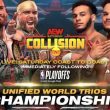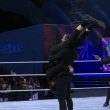Notes from the Nosebleeds #144
November 26, 2011
By: Matt O’Brien of Wrestleview.com
This time of year always reminds traditional fans of WWE’s Survivor Series. Coming off the heels of The Rock’s triumphant return to the ring, it’s hard not to reminisce about the glory days of Survivor Series. Forgotten is the Thanksgiving tradition of Starrcade. Once a Turkey Day holiday, the show eventually shifted to December where it became synonymous with the holiday season in general. It has been said that Starrcade was a precursor to WrestleMania. It was an annual event showcasing great wrestling as well as its fair share of controversy. Its successes and failures mirrored the state of the company as a whole through the years.
Like WrestleMania, Starrcade had a central character for the first several years. Hulk Hogan was the focus of WrestleMania for the first nine years. Even years where Hogan was not in the main event, or lost, the focus was still on him. When Randy Savage was crowned champion at the end of WrestleMania IV, Hogan was there at the end. The same thing happened at the end of WrestleMania VI. Even though Ultimate Warrior was in the ring with his hand raised, all eyes were on Hogan as he left the arena. It wasn’t that Hogan was necessarily being selfish; it’s just the way the show was structured. Hogan was the focal point. WrestleMania IX was a huge change for the company. Hogan had not been on the show since the Mania prior, Warrior was gone, and Savage had taken on a lesser role. Bret Hart vs. Yokozuna as the scheduled main event was so drastically different from the days of Hulk Hogan vs. Randy Savage. Hulk was brought back and placed in an impromptu main event. For many, it felt right. For others, it felt like Hogan was stealing the show for himself. WrestleMania struggled for a few years to find that niche it had with Hogan. Bret Hart, Diesel and Shawn Michaels were all tried as central characters before things settled on Steve Austin.
Like Hogan with WrestleMania, Flair was Starrcade’s central figure. Instead of lining up to see what villain Hogan would have to vanquish, fans paid to see if the newest challenger could shut Flair up and knock him off his high horse. Things changed in 1990 when Sting became the focus. Like WrestleMania IX and Hulk Hogan, Flair became a last minute addition to the main event. The next couple of years the show shifted. WCW used the Battle Bowl concept as opposed big marquee matches. The focus shifted back to Flair in 1993. Vader was the WCW Champion, and a dominant force in the wrestling world. He was easily the top heel in wrestling. While Yokozuna was the immovable object, Vader was the unstoppable force. Nobody could take him down. Flair had appeared as the hero challenging the champion at the inaugural Starrcade in 1983. In 1993, Flair was once again the hometown hero challenging for the championship belt. Starrcade had come full circle on its tenth anniversary.
After that Starrcade began to shift again. After a Hogan-Flair rivalry that ended with Flair retiring at Halloween Havoc, the 1994 event felt anticlimactic with a main vent between Hogan and Brutus Beefcake. Things weren’t much better the following year when the show featured a WCW vs. Japan series. While the theme was something different, like the Iron Man series and Battle Bowl years, it just didn’t have the spark. Part of that could have been the focus of those running WCW. Eric Biscoff himself has admitted he did not see Starrcade as a huge event at first. The Japan show was an interesting idea but it nobody knew who the Japanese guys were. If there really was any sort of war going on, it wouldn’t not be felt until 1996 with the formation of the New World Order.
The big-time feel was back in 1996 when Hulk Hogan squared off against Roddy Piper. It was a match seen many times a decade prior, but things were looking up. It looked as if WCW might refocus the show on Hogan, similar to the way Hogan had Mania focused on him in the 1980s. There was no bigger match at any WCW show than the 1997 event when Hulk Hogan wrestled Sting. A Hogan-Sting match had been a dream match for years, but was now a reality. Even though fans would not see the red and yellow Hogan against the surfer Sting, it was still a dream match. The story had been building for a year and half when the bell finally rang. The ending is widely considered a disappointment and a blemish on the WCW legacy. Regardless, WCW brought in more buys for Starrcade 1997 than any pay per view they ever put on.
The New World Order had mostly faded away by the end of 1998. The name was still used and the music still played, but the war seemed all but over. WCW Champion Goldberg had taken over the show and was one of the hottest acts in the business. WCW tried getting all they could all out of Goldberg in his six month reign that when Starrcade rolled around, Nash was one of the only challengers he had not yet defeated. Like 1997, the 1998 Starrcade ended in a very controversial fashion that fans still debate to this day. Was it a good move to have Nash beat Goldberg? Should Nash have lost? Fans have been left to ponder the alternative scenarios.
The last two Starrcade’s are largely forgotten about, along with a few of the 1980s shows. At that time the company had really fell from the grace of fans that had once stood by them. Still, Starrcade remained a staple until the very end. Pay per view names came and went like so many of the wrestlers did. Names would be pushed aside, then brought back, modified, or just scrapped altogether. Starrcade stayed the same from 1983 all the way until 2000. It remains to this day one of the most significant annual wrestling events in the wrestling history.
Matt O’Brien
Columnist, Wrestleview.com
mattman5436@yahoo.com


